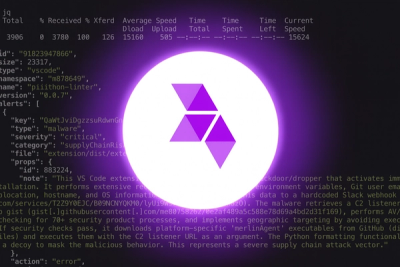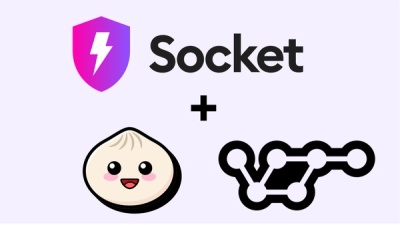
Product
Introducing Socket Scanning for OpenVSX Extensions
Socket now scans OpenVSX extensions, giving teams early detection of risky behaviors, hidden capabilities, and supply chain threats in developer tools.
@loadsmart/icons
Advanced tools
View Demo · Report Bug · Request Feature
A library for using icons at Loadsmart.
You can get it via yarn.
yarn add @loadsmart/icons
You can use Loadsmart icons in your React projects as simple as this:
import { IconAccessorialAirport } from "@loadsmart/icons";
class App extends React.Component {
render() {
return <div> This is an <IconAccessorialAirport /></div>
}
}
TBD
master.js files
yarn prepublish
Unreleased section of the CHANGELOG.md and commit itmasterThe release of loadsmart icons is based on tag
:relaxed: we use Rollbot for release. It will generate a release by bumping the version on the CHANGELOG.md and creating a new tag.
Steps to make a release via Rollbot:
package.json , so we still need to bump the version manually$ yarn bump
It will ask you to put the specific release version, please follow our tag pattern /^\d+\.\d+\.\d+$/ (x.xx.x)
Commit the change in package.json and create a pr [Release] x.xxx.x, once it merges:
Using the /release command in #eng-frontend channel, /release @loadsmart/icons major or /release @loadsmart/icons minor or /release @loadsmart/icons patch
If Rollbot creates the tag successfully, it will send a message saying “tag x.xxx.x created”
Please check CircleCI if all checks of deploy pass, then publish the release in GitHub :beers:
:shipit:If Rollbot doesn't work, please follow these steps as an alternative:
release/x.xx.x)CHANGELOG.md (follow version pattern /^\d+\.\d+\.\d+$/ - x.xx.x)$ yarn bump
It will ask you to put the specific release version, please follow our tag pattern /^\d+\.\d+\.\d+$/ (x.xx.x)
git add the updated package.json and CHANGELOG.md files and commit the changes with a message following the standard:[Release] x.xx.x
This commit message is necessary for our bot to automatically approve and merge the release PR. Please note the brackets enclosing the word "Release" and keep the version in the same pattern used elsewhere.
[Release] x.xx.x):+1: When the CI passes :white_check_mark:, it will automatically merge your PR into master.
Checkout master locally again and pull latest changes
Create a tag, please follow our tag pattern /^\d+\.\d+\.\d+$/ (x.xx.x)
$ git tag <new_tag>
$ git push origin <new_tag>
The Circle CI workflows can be checked here
Circle CI will start a deploy to production :rocket:

For release title, follow the exact same pattern used in the tag version, and for description you can simply insert the respective CHANGELOG.md section.
This last step is what triggers some automated side-effects such as the slackbot that broadcasts new production releases along with their changelog, so don't skip it!
Then you are all set :balloon:
Tip: Always keep semver in mind.
Before starting, keep this in mind about our branches:
master is where the library code resides, all the icons SVG and JS files are here. Code enters here through PRs.To get a local copy up and running follow these simple steps.
Install Yarn:
$ brew install yarn
Clone the project:
$ git clone git@github.com:loadsmart/icons.git
Install local dependencies:
$ yarn
Add your SVG to /src/assets/icons.
$ grunt server
Clean up your SVG file, a good example you can see below.
<svg viewBox="0 0 48 48" xmlns="http://www.w3.org/2000/svg">
<path
d="M19.8 19.8V3h8.4v16.8H45v8.4H28.2V45h-8.4V28.2H3v-8.4h16.8z" fill="currentColor"
fill-rule="evenodd"/>
</svg>
fill="currentColor".width and height in your SVG file$ yarn generateThis command will create a React component for your SVG file, and also will include this component to the library.
FAQs
Icons by Loadsmart
We found that @loadsmart/icons demonstrated a not healthy version release cadence and project activity because the last version was released a year ago. It has 0 open source maintainers collaborating on the project.
Did you know?

Socket for GitHub automatically highlights issues in each pull request and monitors the health of all your open source dependencies. Discover the contents of your packages and block harmful activity before you install or update your dependencies.

Product
Socket now scans OpenVSX extensions, giving teams early detection of risky behaviors, hidden capabilities, and supply chain threats in developer tools.

Product
Bringing supply chain security to the next generation of JavaScript package managers

Product
A safer, faster way to eliminate vulnerabilities without updating dependencies